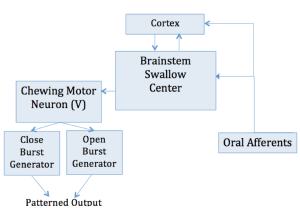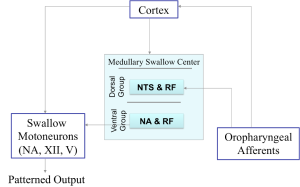Neurophysiology of Swallowing
Neurophysiology of Swallowing
Central pattern generators (CPG) are used throughout physiology. They are functional units of neural circuits capable of generating patterned or rhythmic output either spontaneously (e.g., respiration), or by volitional command or specific stimulus (e.g., walking, chewing, coughing, or swallowing) without dependence on peripheral feedback. In general, pattern generators contain a specific input, an interpreter, and a patterned output. This is achieved through coordinated interaction between afferent fibers and their sensory nuclei, motor nuclei, efferent fibers, peripheral nerves and muscles. Although CPGs may receive cortical input, it is not required.
Of particular interest to swallow function is shared circuitry across pattern generators. There is overlap between the swallow CPG and the respiratory CPG. This allows the swallow CPG temporary influence over the respiratory CPG, thus permitting the occurrence of swallow-related respiratory cessation (deglutitive apnea).
There is also overlap in the swallow CPG and the cough CPG (Troche, Brandimore, Okum, Davenport, & Hegland, 2014). The combined effort of these two CPGs provides airway protection. The swallow CPG closes off the airway during the swallow; the cough CPG expels any material that violates the airway entrance.
Chewing Pattern Generator
The CPG for chewing is located in the brainstem (Box 1.58). It can be activated by input from the cortex or from specific peripheral inputs to the brainstem near the motor nucleus of CN V and the surrounding reticular formation. The result is a rhythmic pattern of jaw opening and closing. This pattern can be modulated to incorporate adequate bite force or size of the chewing gesture (modulating the timing of the open and close phase, or the amplitude of jaw muscle contraction). Peripheral inputs aid in this modulation, and also provide input to excite jaw reflexes as needed. For example, if while chewing the texture of the bolus is suddenly altered (like finding a small pebble in your pasta), reflexes would engage to open the jaw. Although cortical inputs help modulate chewing, the rhythmic pattern of chewing will continue even if the cortex is separated from the brainstem.
Box 1.58: Schematic of chewing pattern generator

Swallow Pattern Generator
To trigger the pharyngeal swallow, the CPG for swallowing receives a stimuli from oropharyngeal afferents that feed to the nucleus tractus solitarius, (NTS) and the surrounding reticular formation in the brainstem (Box 1.59). The neurons for the swallow CPG are located in the medulla of the brainstem. These neurons can be divided into two groups–the dorsal and ventral group. The dorsal group, which incorporates the NTS and the surrounding reticular formation, serves as a command center for swallowing. The input is interpreted to determine if it is adequate to trigger a swallow. In order to trigger a swallow, the stimuli must excite multiple oropharyngeal receptor fields, the stimuli must be dynamic, and the receptor’s afferents must synapse in the region of the NTS. If the input is adequate, it is interpreted and integrated so that an appropriate swallow response is generated. Information about the bolus and the state of the system comes from the oropharyngeal afferents and is distributed to cortical, midbrain, and brainstem regions. This combined information is then integrated in the dorsal region of the medullary swallow center. Although swallowing can occur without cortical input, information from the cortex helps refine the motor pattern. For example, information sent from the cortex to the dorsal neuron group allows the integrator to adjust for bolus volume, consistency, and temperature. The end product will be a swallow pattern best suited to handle the bolus. The dorsal group of the swallow CPG will submit information regarding the recommended swallow pattern to the ventral group. This information may include required muscle groups, firing order, firing strength, and firing duration etc. The ventral group, which is located around the nucleus ambiguous (NA) and other switching neurons, is responsible for implementing the plan. This neuron group distributes the needed neural drive to the various motor neuron pools required to fulfill the pattern. The end result is a safe and efficient swallow for the specific bolus.
Box 1.59: Schematic of swallow pattern generator

NTS = Nucleus Tractus Solitarius
RF= Reticular Formation
NA= Nucleus Ambiguus
As noted in the schematic of the swallow pattern generator, the cortex is involved in the swallow. Currently, research is being conducted to better elucidate the importance of other brain structures, such as the cerebellum, in swallow physiology.
Clinical Note
In patients with respiratory compromise, it is possible for the respiratory control centers to modify the plan set out by the central pattern generator for swallowing. The end result may be changes to onset and duration of swallow-related respiratory cessation, thus exposing the airway entrance during bolus flow through the pharynx.

